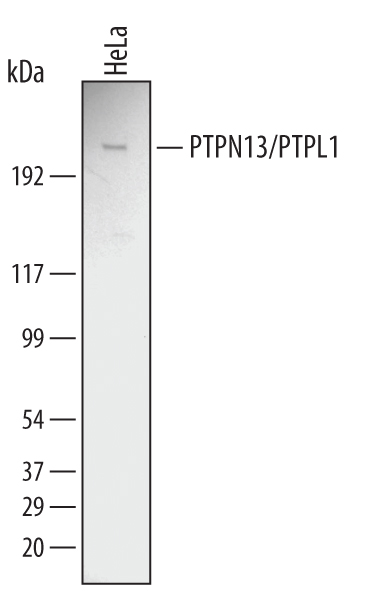Human PTPN13/PTPL1 Antibody
R&D Systems, part of Bio-Techne | Catalog # AF3577

Key Product Details
Species Reactivity
Applications
Label
Antibody Source
Product Specifications
Immunogen
Met1-Arg500
Accession # Q12923
Specificity
Clonality
Host
Isotype
Scientific Data Images for Human PTPN13/PTPL1 Antibody
Detection of Human PTPN13/PTPL1 by Western Blot.
Western blot shows lysates of HeLa human cervical epithelial carcinoma cell line. PVDF membrane was probed with 1 µg/mL of Human PTPN13/PTPL1 Antigen Affinity-purified Polyclonal Antibody (Catalog # AF3577) followed by HRP-conjugated Anti-Goat IgG Secondary Antibody (Catalog # HAF109). A specific band was detected for PTPN13/PTPL1 at approximately 260 kDa (as indicated). This experiment was conducted under reducing conditions and using Immunoblot Buffer Group 1.Detection of Human PTPN13/PTPL1 by Western Blot
PTPN13 regulates MDA-MB-231 cell motility and invasiveness. A: Expression of wt (N13-1, N13-2, N13-3) or catalytically inactive (CS) PTPN13 in the indicated cell clones was monitored by western blotting using anti-PTPN13 antibodies. Mock: control cells (vector alone); equal loading was verified by re-probing with an anti-actin antibody. B: Cell growth measured using the MTS assay. Results, expressed as % of Mock cells, are the mean ± s.d. of three (N13-1) four (N13-2, N13-3) or five (Mock, CS) independent experiments. C: Directional migration was assessed with the wound healing assay. C. Upper panel: Phase-contrast optical photomicrographs of the wounded area at 0 and 9h. C. Lower panel: Quantification of cell migration, expressed as % of Mock cells; mean ± s.d. of 3 (N13-1) or ≥5 (Mock, N13-2, N13-3, CS) independent experiments. **P<0.01, ****P<0.0001 versus Mock. D: Individual migration of the indicated cell clones was monitored by video microscopy and cell tracking on duplicate wells in three independent experiments. Graph represents the speed of about 1500 cells for each clone, Box-plot whiskers represent the 5 and 95 percentile values; ****P<0.0001 versus Mock and CS. E: Classification of cells (percentage) according to their migration speed (as in panel E): slow (<20µm/h), medium (20 to 40µm/h) and fast (>40µm/h). F: Cell invasiveness was evaluated with the Boyden chamber test. The percentage of cells that migrated through Matrigel-coated filters was quantified relative to the total number of seeded cells. Results, expressed as % of Mock cells, are the mean ± s.d. of five (N13-1), three (N13-2, N13-3) or two (CS) independent experiments *P<0.05 versus Mock. (C, D and F) two-tailed Student's t-test. Image collected and cropped by CiteAb from the following publication (https://pubmed.ncbi.nlm.nih.gov/31938048), licensed under a CC-BY license. Not internally tested by R&D Systems.Applications for Human PTPN13/PTPL1 Antibody
Western Blot
Sample: HeLa human cervical epithelial carcinoma cell line
Formulation, Preparation, and Storage
Purification
Reconstitution
Formulation
Shipping
Stability & Storage
- 12 months from date of receipt, -20 to -70 °C as supplied.
- 1 month, 2 to 8 °C under sterile conditions after reconstitution.
- 6 months, -20 to -70 °C under sterile conditions after reconstitution.
Background: PTPN13/PTPL1
Protein Tyrosine Phosphatase, Non-receptor Type 13, also called PTPN13, PTPL1, FAP-1, hPTP1E and PTP-BAS, is a 260 kDa intracellular protein that removes phosphates from tyrosine residues. Genetic aberrations in PTPN13 have been reported in a wide variety of cancers, including, bone, colon, hepatocellular, and germ cell line. Elevated levels of PTPN13 in cancer cell lines have also been correlated with resistance to Fas-induced apoptosis, possibly due to prevention of CD95 reaching the cell surface.
Long Name
Alternate Names
Gene Symbol
UniProt
Additional PTPN13/PTPL1 Products
Product Documents for Human PTPN13/PTPL1 Antibody
Product Specific Notices for Human PTPN13/PTPL1 Antibody
For research use only

